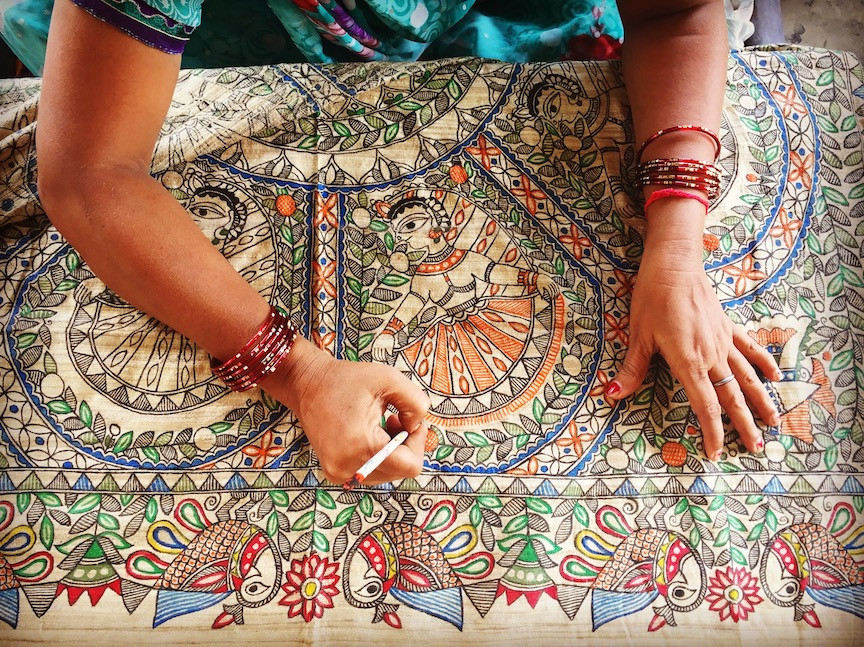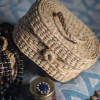Through art, paintings, dance, folk music, festivals, and fairs, Bihar reflects its glorious past and rich cultural heritage. From paintings to visual arts, the themes mostly illustrate myths and legends of the Hindu religion. The folk paintings exemplify the Hindu deities, such as Lord Rama, Sita, Lord Shiva, Parvati, and so on. Ancient stories involving the Gods, Goddesses, sages, and legends are found to be depicted in the meticulously designed handicrafts. Bihar houses several Buddhist Monasteries, and hence, the state is also known as 'The Land of Buddha'.
Arts and Handicrafts of Bihar
Sikki Art
Mostly found in Bihar, and other middle-eastern states of India, this gold-tinted grass is considered auspicious by the natives. There are hardly any rituals or holy ceremonies where Sikki grass is not offered to the deities. However, women are skilled to utilize these grasses to craft several beautiful items. After cutting the flower heads, Sikki is dried, which results in the production of fine gold-tinted glass. They are then employed to weave dolls, toys, jewellery boxes, and several other utilities and decorative products. “Pauti”, the woven baskets are used by the natives to exchange gifts.
Stone Craft
Since ancient eras, stone craft has been one of the most prevailing arts of Bihar. The Pattharkatti region of Atri in Gaya, Nalanda, and Patna are some of the major centres of such magnificent art. The effortless accessibility to black stones, dexterous craftsmen, and their intricate skills have been the causes for the sharp progress of stone craft in Bihar.
Traditional techniques of stone polishing are done in Gaya, which ranks as one of the largest producers of stone crafts in Bihar. Stone statues of various deities of Gods and Goddesses, utility items such as bowls, coasters, mortar kharal (medicine grinder), tableware, and so on are found in plenty.
The Ashoka Pillar at Sarnath stands out as one of the most majestic and magnificent artistic excellence of the ancient artisans of Bihar.
Tikuli Art
This innovative handicraft originated in Patna almost 800 years ago. The artisans melted down broken glasses and created this unique art form. Melting the glasses is necessary to provide the desired size and shape. After smoothening out the sharp edges, mythological stories, women, nature, dancing figures, and so on are etched and glazed with enamel paint. Nowadays, gradually pieces of hardboards are replacing the glasses.
Brass and Bell Metal Craft
Rose to the zenith during the Mauryan dynasty and later during the Gupta dynasty, the metal art of Bihar dates back to pre-historic ages when the artisans were even patronized by the Royal families. Artisans employ the innovative lost-wax technique to prepare the craft items.
Excellent craftsmanship is noticed in the brass and bell metal crafts of God, Goddesses, utensils, and other utility items.
Wood Carvings and Wood Inlay
One of the most popular as well traditional artwork, the ancient craft of wood carvings has still been preserved. Gradually, it has been converted to a means of livelihood for the local artisans. Among all other Indian states, Bihar is one of the very few places where wood inlay work is done. Here, hand-crafted decorative wooden items are inlaid with diverse materials, lending a royal and elegant look.
It is said that King Ashoka’s royal throne, wooden doors, royal gates, and panels of the temples were hand-crafted by the dexterous artists of Bihar. Wooden toys and daily items are created with great finesse in Patna, which also forms a major centre for the manufacturing of carved wooden doors and windows.
Pottery and Ceramics
The archeological excavations in Nalanda and Rajgir put forward evidence of the rich history that Bihar associates with clay pottery work. The existence of this artistic craft is traced back to the time of the Mauryan and Gupta dynasties.
The potters of Bihar beautifully craft earthen utensils and tiles. The products are often adorned with skillful designs, accentuating their charm. Patna is also a creative hub for earthen statutes of several deities.
Paintings of Bihar
Madhubani Painting
Remarkably renowned for its extraordinary rustic charm, Madhubani painting is widely practiced throughout Bihar’s Mithila region. Women from various communities come together to practice and spread the art form. Traditionally, women painted the freshly plastered mud walls and floors of the huts. However, presently, the use of handmade paper, canvas, and fabric material as a background material has become prevalent.
Highly acclaimed for being confined to a particular geographical area, Madhubani painting has bagged Geographical Indication (GI) status. The natural colours are extracted by skilled artisans from plants and they blend them with the paste of powdered rice to form the paint. Employing the innovative two-dimensional imagery, Madhubani paintings usually depict common people and their relationships with their surroundings, such as nature, and deities from ancient myths and epics.
Some of the commonly painted themes also include the sun, the moon, scenes from the royal court, and holy plants such as tulsi.
One of the unique aspects of this painting is hardly any space is left empty. The little gaps are filled by intricate artworks of flowers, birds, animals, and geometric designs. In the Mithila region, the tradition of Madhubani painting is passed on for generations, especially by women. Gradually, this tradition is spread across to other places as well.
Manjusa Art
Also termed as Snake paintings, it is believed that Manjusa art is the only art form that illustrates a sequential representation of a story. The paintings are displayed in a series and hence, this is also known as scroll painting. Originated in the laps of Bhagalpur in Bihar, this folk art dates back to the 7th century.
It is fascinating to note that the word “Manjusa”, meaning ‘a box’ in Sanskrit, is also associated with a Goddess, an elaborate story, and even a festival celebrated in Bhagalpur.
Generally, through this art, the tale of Bihula’s love and sacrifice is told, highlighting the ways she went beyond her means to save her husband from the wrath.
Picture Source: Insights



